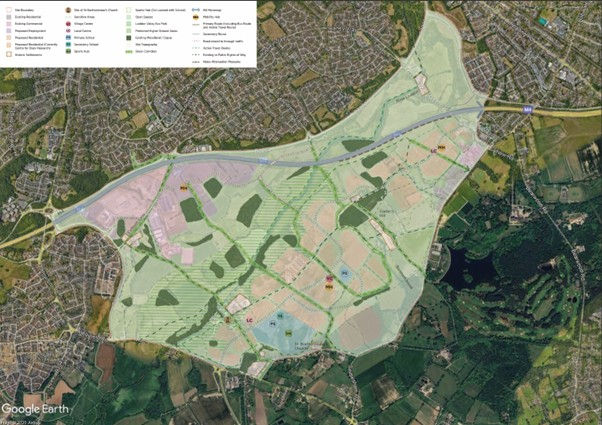Brownfield not Greenfield, please!
- paulstevens24

- Jan 17, 2023
- 4 min read
In a recent edition of the Daily Express was an article headlined “Rural villages 'under assault' by greenfield property development”. In it they report that “Analysis by the Campaign to Protect Rural England suggests there are currently more than 400,000 homes with planning permission on greenfield sites. Even if planning applications are rejected at local authority level as inappropriate they are often being granted permission at national level on appeal, councillors report. The result is massive pressure on services such as doctors, dentists, schools and village lanes clogged with traffic - and the despoiling of some of the most beautiful parts of the British countryside”.
This follows a recent article in the Reading Chronicle reporting that Councils in Berkshire should NOT be planning to build thousands of new houses in the countryside . The reason given being the huge number of Brownfield sites available. (Brownfield sites are sites that have previously been developed but are now available for redevelopment). In both articles the source quoted for the information is a report written by the Campaign for the Protection of Rural England (CPRE).
This report headlines with “Brownfield land for 1.2 million homes lying dormant” and in it the CPRE calls for broad amendments to the National Planning Policy Framework. The NPPF is due for review in 2023 and among the CPRE's recommendations are:
· Only allowing greenfield developments when they are primarily affordable housing for local needs, or when as much use as possible is already being made of brownfield land.
· The New Homes Bonus should be reformed so it is only paid out to support either development of brownfield land and/or additional affordable homes.
· The Infrastructure Levy should be set at a much higher rate on greenfield land to reflect the high costs of greenfield development to local communities.
· Provide local communities with stronger mechanisms to bring brownfield land forward as a source of land supply, such as increased compulsory purchase powers.
These are all highly commendable ambitions, with which many of us must surely agree. But sadly the bottom line seems to be that money talks more loudly than any sensible plan to actually solve the housing problems faced by so many.
For example, we can all agree there is a definite shortage of houses available for first time buyers to buy. It is also patently unfair that young people are priced out of home ownership while older people sit on massive increases in the value of their homes. Yet it is the shortage of housing supply that drives the increasing value of houses. Presumably if there were no housing shortages then the prices would stabilise? It is the uneven value of property in the over crowded South East that is driving the developers to want to build here, rather than in less crowded, more affordable areas of the country.
The CPRE report says Reading has 140 brownfield sites, 126.35 hectares, sufficient for 10,124 houses – the largest housing capacity in the county. It also claims that across Berkshire there are 359 such sites across the county, which would be sufficient to build at least 21,000 homes! This is more than enough to solve local housing need.
So, given the controversy that surrounds digging up green field sites for houses, why are brownfield sites being ignored?
To quote from the CPRE report : “Despite the many positives of using brownfield land for development, the senseless destruction of our countryside continues in the pursuit of developer’s profits and is only likely to become worse. Continued deregulation will likely erode many environmental protections and make it even easier to build on our green lands. This will have devastating consequences for our countryside, and climate and nature targets”.
I can accept that building on brownfield will not be as easy as building on greenfield. Often the site will need work to prepare it and to ensure there is no contamination of the land. This does make for a higher initial cost when compared to building on greenfield sites. Developers argue that the cost burden of cleaning the land should belong to the Government. Otherwise, they say, the price tag will have to be passed on to home buyers, putting the affordable home concept into jeopardy.
But what of the long term costs of opting for greenfield over brownfield.? What price building on greenfield sites when they absorb excess carbon and capture excess rainfall? Can it really make economic sense to increase flood risk through exacerbating global warming? Most Climate Scientists are now of the opinion we are approaching a “tipping point” in global temperatures. There is no way of knowing how, or when the balance point will be crossed, but it is feeling more imminent with every flood, drought, tornado and famine across our rapidly over heating world. Generally the feeling is we are getting very close to the point beyond which it may be impossible to turn back.
Hotter air holds more moisture. More moisture in the air means more intense rainfall. Our warmer atmosphere is leading to melting ice caps. Melting ice caps reflect less of the heat from the sun. Meanwhile emissions from fossil fuels add carbon to the atmosphere. Carbon, and other “Greenhouse gases” such as methane, trap more heat inside the atmosphere, which in turn accelerates the effects of the hotter atmosphere.
To put it bluntly, can we really afford NOT to build on brownfield sites?





well said again Paul ,maybe after the election we may councillors who listen to local views rather than the greed of developers